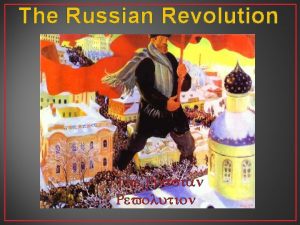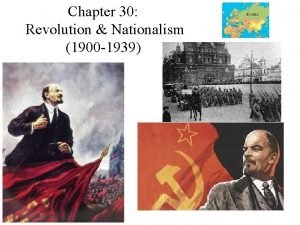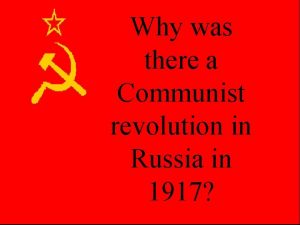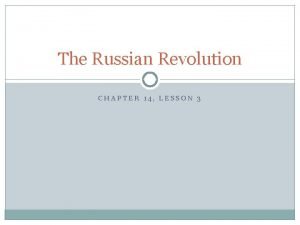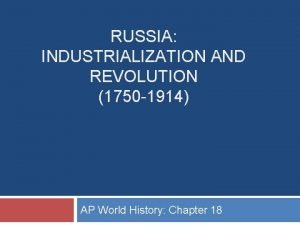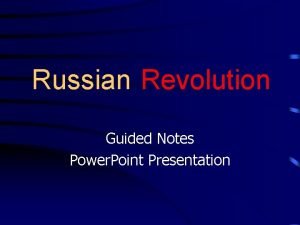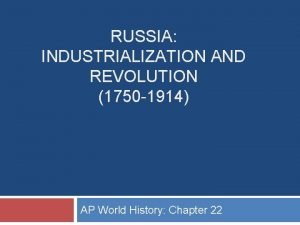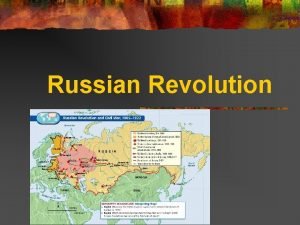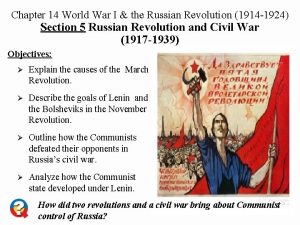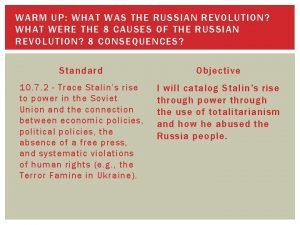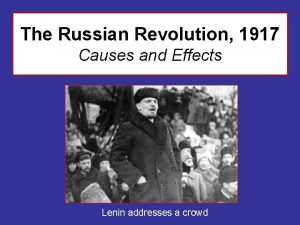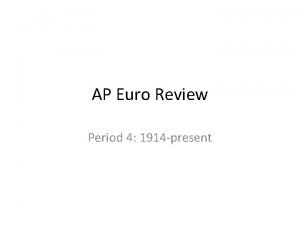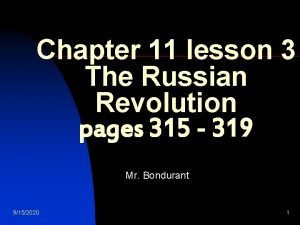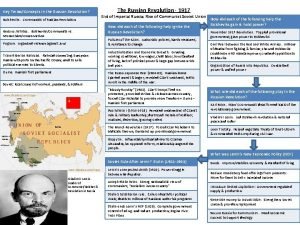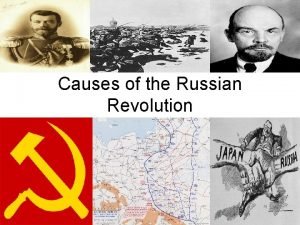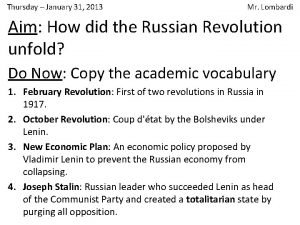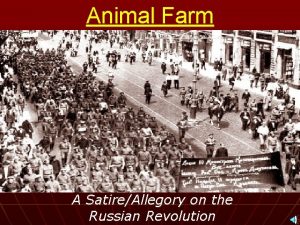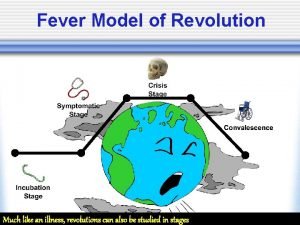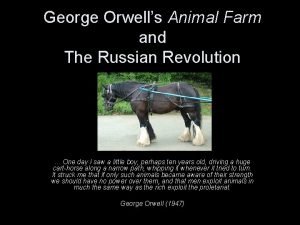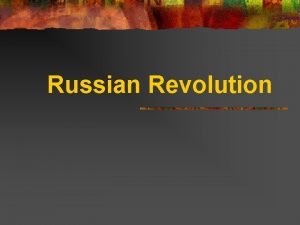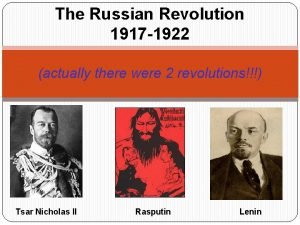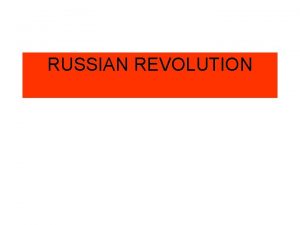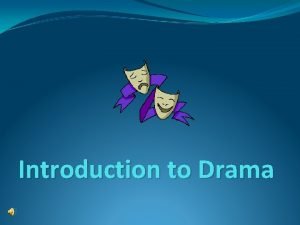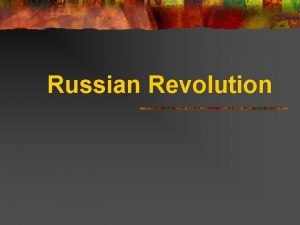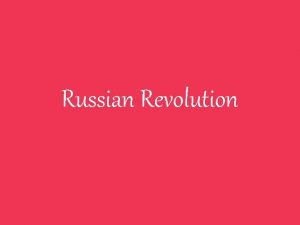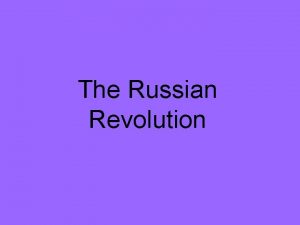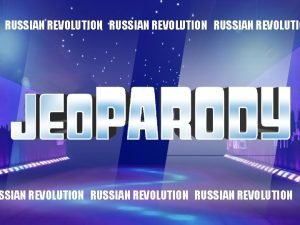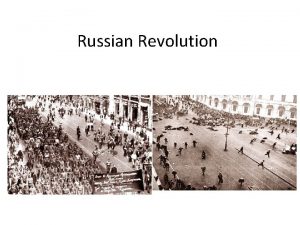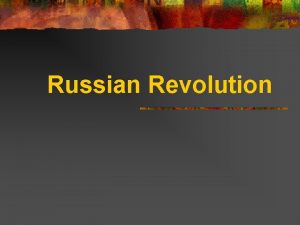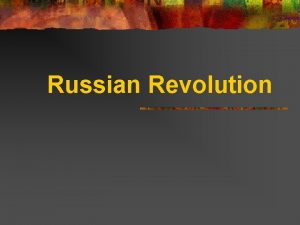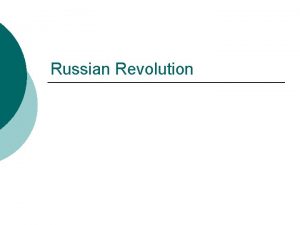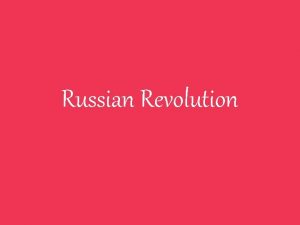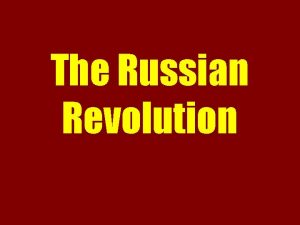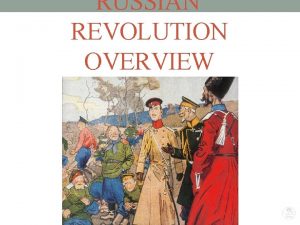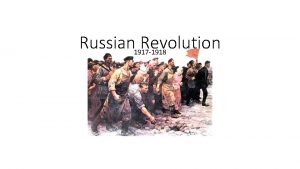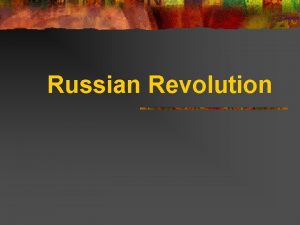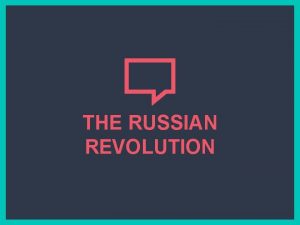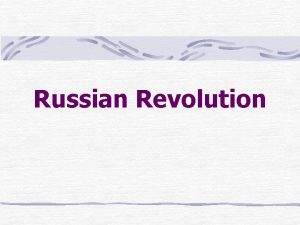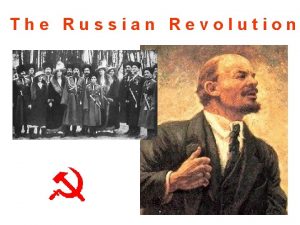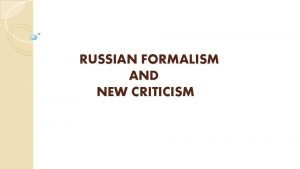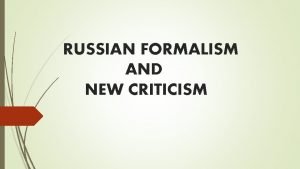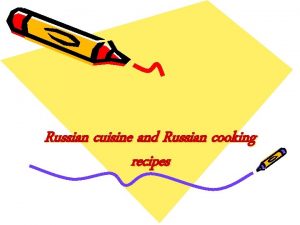Stages of a Revolution The Russian Revolution Stage































- Slides: 31

Stages of a Revolution: The Russian Revolution

Stage One Examples • • • • Small middle class that resented the privileges of the nobles 4/5 or 90% of the population was peasant 20% of population were factory workers known as soviets Followed feudalism and relied on serfdom Skyrocketing cost of bread and bread rationing Food and fuel shortages Inefficient transportation system Not industrialized Loss in the Japanese-Russo War Enormous losses in World War One Slogans of “Peace and Bread”, “Peace, Land, and Bread”, “Down with Autocracy”, “Worker Control of Production”, “All Power to the Soviets” Czarina Alexandra did not care about workers and peasants…. focus on lifestyle, family, son’s hemophilia, and influence of Rasputin Weak leadership of Czar Nicholas II Secret police Czar Nicholas tried to crush the Duma (Parliament)


Russian failures in the First World War The weakness of Tsar Nicholas II The discontent of the peasants The discontent of the workers Factors that led to the Communist revolution in 1917. Rasputin and scandal The failure of the Duma Opposition of the Communists The February Revolution 1917

Stage Two Examples • Lenin: led the Bolsheviks, communist, followers were the soviets who were like the sans-culottes, slogans of “Bread, Peace, and Freedom” and “All Power to the Soviets” • Trotsky: part of the Bolsheviks, forms the Red Guard and is similar to Marquis de Lafeyette and the National Guard—develops the Red Guard into the Red Army of 5 million men • Marxism • Censorship of all anti-government activities

Stage Three Examples • 1905 -Bloody Sunday: a peaceful protest of 200, 000, but guards open fire and kill 1000 • February/March Revolution: March 8, 1917, 10, 000 working class women led a series of strikes in Petrograd/St. Peterburg chanting “Peace and Bread” and “Down with Autocracy”---similar to Women’s Bread March on Versailles • March 10, 1917: All factories shut down and go on strike in Petrograd and soldiers join in---similar to the Storming of the Bastille • Assassination attempts and final assassination of Rasputin

Bloody Sunday

Bloody Sunday (1905)


Stage Four Examples • Duma met on March 12, 1917 to establish a Provisional Government made up mostly of the middle class like the National Assembly and later the Legislative Assembly • Had Czar Nicholas II step down and got rid of the monarchy like at the end of the Legislative Assembly • Provisional Government led by Alexsandr Kerensky---it is a moderate republic • Development of Soviets---workers’ councils to give the working class a voice because they feel the Provisional Government does not represent them

Stage Five Examples • Adopt a new calendar like rest of Western world in 1918 • Establish civil rights like the Declaration of the Rights of Man and Citizen and the Constitution of 1791 • Promised free elections • But involvement in World War One is made number one priority and alienates a large portion of the population who want out of the war like what the Civil Constitution of the Clergy and limited voting rights did in France

Stage Six Examples • Civil War in Russia-brought on primarily over continued involvement in World War One • Whites: anti-communists and supporters of the Provisional Government like the Girondins • Reds: communists-Bolsheviks like the Jacobins • Liberals: made up of the middle class and wanted a constitutional monarchy • Socialists: more democratic, did not follow Lenin, mostly peasants who wanted more land rights • Communists: radicals and followers of Lenin • Communists broken into Bolsheviks led by Lenin and Mensheviks led by Trotsky • Kornilov Affair

Kornilov Affair • General Kornilov attempted to overthrow Provisional Government with military takeover • To prevent this takeover, Kerensky freed many Bolshevik leaders from prison and supplied arms to many revolutionaries

Whites and their supporters fleeing abroad after defeat in the Civil War

The Treaty of Brest-Litovsk 1918 Russia Estonia Germany . Latvia Lithuania Ukraine Brest-Litovsk Russian territory ceded to Germany

Reaction to Treaty • Bolsheviks’ acceptance of peace treaty angered many Russians • Bolsheviks’ opponents organized the White Army • White Army included army leaders, political opponents, wealthy Russians opposed to Communist system Civil War • White Army received military help from France, U. S. • Civil War raged for 3 years between Lenin’s Red Army and White Army • Millions of Russians died in fighting, famines • Bolsheviks finally triumphed, late 1920

Stage Seven Examples • October/November Revolution of 1917: Provisional Government and rule of Kerensky is overthrown • Bolsheviks win the civil war • Lenin is in charge---like Robespierre • Execution of entire royal family without a trial • Tried to get rid of organized religion • Red Terror led by the secret police known as Cheka---eliminate all opponents to Lenin like Reign of Terror and Committee of Public Safety • Illegal to own private property • Land given to peasants • New Economic Policy • Workers given control of factories • Gave women equal rights and pay • Legalized abortions • Made it easier to divorce • Took control of Soviets • Creates a Proletarian Dictatorship


New Economic Policy Collapsing economy • Brought on by civil war, pushed Russia to edge of total ruin • Peasants, workers especially hard hit • Lenin introduced New Economic Policy, 1921 Key points • New Economic Policy permitted some capitalist activity • Peasants could sell food at profit • Tried to encourage badly needed food production The Soviet Union • Russia reunited with several neighboring lands, became Union of Soviet Socialist Republics, dominated by Communist leadership • Lenin’s death in 1924 led to struggle for control of Soviet Union

The Cheka (or secret police) In December 1917 Lenin set up a secret police force known as the Cheka agents spied on the Russian people in factories and villages. Anyone suspected of being anti-Communist could be arrested, tortured and executed without a trial. When opponents tried to assassinate Lenin in 1918, he launched the Red Terror campaign against his enemies. It is said that 50, 000 people were arrested and executed in this period.

Stage Eight Examples • Lenin dies in 1924 by natural causes • The Politburo is created---a seven member ruling government from membership of the Communist Party like the Directory • Power struggle about who would lead next between Trotsky and Stalin

Who would succeed Lenin? OR Trotsky – Red Army Commander and Commisar of Foreign Affairs Stalin – Commisar for Nationalities

Leon Trotsky • intellectual, head of the Red Army • favoured the doctrine of World Revolution – felt that the USSR could not survive as the sole comm. state – the USSR must therefore seek to export rev. – as a doctrinaire comm. , he opposed the NEP

• favoured “Socialism in One Country” – the USSR should strengthen itself and lead the comm. world by ex. • as a pragmatist, he supported the NEP • experienced as a bureaucrat, he became the Party’s General Secretary in 1922: here he appointed many apparatchiks (these allies were crucial to Stalin’s rise) • their power struggle lasted until 1928, when Stalin’s complex system of alliances and ability w/ realpolitik allowed him to succeed • even Lenin’s doubts couldn’t deter Stalin, and many involved in the party hierarchy paid more attention to one another than to Stalin Josef Stalin

Stage Nine Examples • Stalin’s Dictatorship like Napoleon as Emperor • Built new cities and lakes all named after Stalin • Five Year Economic Plans • Increased oil production • Increased coal and steel production • Established a massive public school and university system to create a literate population who is loyal to Stalin • Creates an 85% literacy rate • New middle class of young men from the working class newly educated and loyal to Stalin • Collectivization of agriculture • Purge of Kulaks • Creation of Labor Camps and Gulags • 8 million people sent to the camps and gulags • 5 million were killed • Virtual slave labor of millions of peasant to build canals, dams, and factories • Complete censorship of all forms of communication • Major propaganda campaign just like Napoleon

Stalin’s Totalitarian State • State Control of the Economy – 5 year plan, collective farms • Police Terror – Great Purge, crush opposition • Religious Persecution – Control of the individual • Propaganda (socialist realism) – Molding peoples minds • Education – Controlled by the government

Collective Farming: All farmers are forced to give up their own farms and work and farm in groups. It was a huge failure.

We are 50 -100 years behind the advanced countries. We must make up this gap in ten years. Either we do it or they crush us. Stalin 1931 The Five Year Plans • Stalin believed that industry could only develop through state control. Under GOSPLAN, three Five Year Plans set targets between 1928 -1941 to increase production. • Russian industry changed enormously. • New towns such as Magnitogorsk grew up and large projects such as the Dnieper hydroelectric dam were developed. • The USSR became a major industrial country. • The human cost was high. • Forced labour killed millions, working conditions were poor and hours of work were long.

A drawing by Evfrosiniia Kersnovskaia, a former Gulag prisoner. Courtesy of Evfrosiniia Kersnovskaia Foundation, Moscow.


The Great Patriotic War 1941 -1945 When Germany attacked the USSR in 1941, Stalin used the same ruthlessness to defend his country. The defence of the USSR was the bloodiest war in history and cost the lives of millions of people and the destruction of thousands of villages, towns and cities. The final victory in 1945 was, like everything else, put down to the personal leadership of Stalin by the Soviet propaganda machine. After the war, Stalin built up the USSR as a superpower, in opposition to the USA. This conflict was known as the Cold War. Stalin died in 1953.
 Russian revolution vs french revolution
Russian revolution vs french revolution In the view of this cartoonist russia under
In the view of this cartoonist russia under Russian revolution vocabulary
Russian revolution vocabulary Introduction of russian revolution
Introduction of russian revolution Lesson 3 the russian revolution answer key
Lesson 3 the russian revolution answer key Russian revolution of 1905 definition ap world history
Russian revolution of 1905 definition ap world history The russian revolution guided notes
The russian revolution guided notes Russian revolution of 1917 definition ap world history
Russian revolution of 1917 definition ap world history The russian revolution
The russian revolution Chapter 14 world war 1 and the russian revolution
Chapter 14 world war 1 and the russian revolution Russian revolution causes and effects
Russian revolution causes and effects Causes and effects of the russian revolution
Causes and effects of the russian revolution Triple alliance ap euro
Triple alliance ap euro Lesson 3 the russian revolution
Lesson 3 the russian revolution Russian revolution cartoons
Russian revolution cartoons Russian revolution
Russian revolution Effect of russian revolution
Effect of russian revolution Who lost territory after ww1
Who lost territory after ww1 Causes of the russian revolution
Causes of the russian revolution Summary of animal farm
Summary of animal farm Fever model revolution
Fever model revolution Animal farm
Animal farm World war 1 and the russian revolution chapter 27
World war 1 and the russian revolution chapter 27 Http://www.history.com/topics/russian-revolution
Http://www.history.com/topics/russian-revolution How did vladimir lenin influence the russian revolution
How did vladimir lenin influence the russian revolution Russian revolution
Russian revolution Directions types
Directions types Stage left and right
Stage left and right Difference between single stage and two stage tendering
Difference between single stage and two stage tendering Stage 1 denial
Stage 1 denial Stage right stage left diagram
Stage right stage left diagram Downstage and upstage
Downstage and upstage

